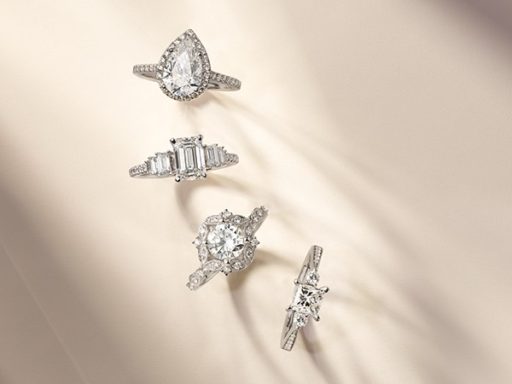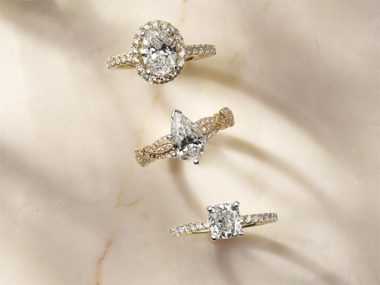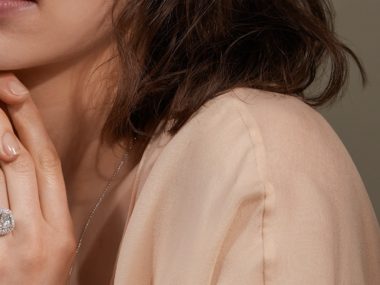Cut, Carat, Clarity and Color – even if you’re aware of the 4 Cs, the process of buying a diamond can still seem completely intimidating. How do you know you’re making the right choice? Which “C” should you prioritize when looking for a stone? How do you make sure that it fits into the ring setting you chose? Don’t worry! Your friends at Shane Co. are here to help with How to Buy a Diamond: The Ultimate Guide.
Step one: Learn the 4 Cs

The grading criteria that jewelers use to determine the quality of a diamond. Here’s a quick tutorial just in case:
Carat: Diamonds are measured in carats, which is a unit of weight. One carat weighs 200 milligrams, and, generally, the higher the carat amount, the more expensive the diamond will be.
Clarity: Clarity refers to internal flaws in a diamond. The most recognized and commonly used GIA scale ranges from I3 (inclusions visible to the naked eye) to F/IF (completely flawless under 10x magnification).
Color: At a glance, you may think all diamonds look about the same, but diamonds range in color from light yellow to colorless and are graded from a range of W (light yellow) to D (colorless).
Cut: Diamonds are meticulously, thoughtfully and very carefully cut to produce the most sparkle. This attribute, the cut, is graded on a scale of “Poor” to “Ideal.” A cut that is too shallow or deep will make the diamond appear smaller and less sparkly than it actually is.
Step two: Choose your budget

Deciding on a budget can be helpful to do early in the engagement ring buying process so that you don’t end up choosing one that’s completely out of reach. Most people decide on a price range they’d prefer to stay in and move forward from there. Note that your budget will most likely include the loose diamond you choose in addition to the setting, which leads us to the next step…
Step three: Decide on a setting style
Whether or not you buy the setting beforehand, it’s important to at least have an idea of what you or your partner is looking for, as there may be certain settings that look better with particular diamond shapes. In addition, if you’re looking for a simple setting, you’ll have more room in your budget for the center stone – or less, if you’re looking for a more detailed setting.
Step four: Determine what you value the most
Is size a priority when searching for the perfect diamond? Or would you rather have a beautiful cut, even if it means sacrificing the carat weight? Figuring out which aspects of the 4 Cs you value the most will help you immensely on your diamond-shopping journey. Often, deciding to go for a slightly lower grade in clarity or color can give you more wiggle room when looking for a larger, well-cut diamond.
Step five: Choose a shape

Diamonds come in 10 shapes: round, cushion, princess, emerald, marquise, heart, oval, pear, asscher and radiant. They all vary in price and can create unique looking rings. Knowing which shape you or your partner is looking for beforehand can make it easier to look at options when you’re working with a jeweler. If you’re purchasing an engagement ring for your significant other and are not sure what shape she likes, a round brilliant is usually a safe bet – 53% of engagement ring sales consist of a round diamond. To learn more about diamond shapes, study up with this blog post.
Step six: Find a jeweler you can trust
Building an engagement ring is a special experience, and it should be treated as such. This is a rare purchase, one that probably has more sentimental value than financial. Finding a jeweler that will offer a personalized, easy, informative and stress-free experience will help you enjoy the journey, rather than spending any time worrying if you’ve made the right choice. Shane Co.’s non-commission staff of diamond experts will help guide you to the perfect stone, even if you’re not sure where to start.
Step seven: Compare, compare, compare
The easiest way to find out if you’ve found the perfect diamond is to compare them to others. Did you know that even diamonds within the same grade can appear quite different? At Shane Co., we offer a diamond subjectivity kit that allows you to compare diamonds – even those of the same grade – so you know exactly what you’re getting. Here’s a tip: the grade of a diamond is simply a marker of its attributes. The best way to determine how it’s going to look in an engagement ring is to inspect it in person, in natural-looking light.
Step eight: Complete your ring

Once you’ve decided on a diamond, it’s time to put together your ring! At Shane Co., you can choose a loose stone and engagement ring setting at the same time and our expert jewelers will assemble and size your ring to your specifications. You can even customize further with engravings and unique decorative crowns.
That’s it! If you have any other questions about the diamond buying process, visit us in-store or contact us to speak with one of our jewelry experts. We love providing our customers with the tools they need to make an informed decision that they’re truly satisfied with – because that’s what a friend would do.





I won’t a black diamond 14 k white gold ring
Our black sapphires are a great alternative to black diamonds! You can design your own engagement ring here: https://www.shaneco.com/engagement-wedding/engagement-rings
You are missing the trillion cut – one of the most beautiful cuts for a solitaire setting.
What if I wan just a nice ring for myself that isn’t an engagement ring. What are my alternatives.
I am looking for a double halo ring and do not know which one to get and the type of diamond or kentucky deep blue sappire